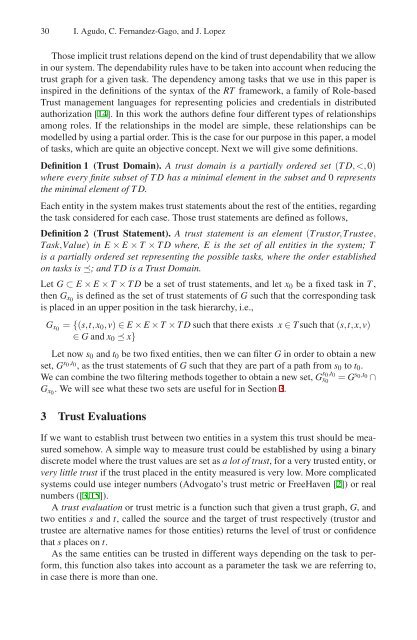30 I. Agudo, C. Fernandez-Gago, and J. Lopez Those implicit trust relations depend on the k<strong>in</strong>d of trust dependability that we allow <strong>in</strong> our system. The dependability rules have to be taken <strong>in</strong>to account when reduc<strong>in</strong>g the trust graph for a given task. The dependency among tasks that we use <strong>in</strong> this paper is <strong>in</strong>spired <strong>in</strong> the def<strong>in</strong>itions of the syntax of the RT framework, a family of Role-based Trust management languages for represent<strong>in</strong>g policies and credentials <strong>in</strong> distributed authorization [14]. In this work the authors def<strong>in</strong>e four different types of relationships among roles. If the relationships <strong>in</strong> the model are simple, these relationships can be modelled by us<strong>in</strong>g a partial order. This is the case for our purpose <strong>in</strong> this paper, a model of tasks, which are quite an objective concept. Next we will give some def<strong>in</strong>itions. Def<strong>in</strong>ition 1 (Trust Doma<strong>in</strong>). A trust doma<strong>in</strong> is a partially ordered set (TD,
A Model for Trust Metrics Analysis 31 3.1 Trust Functions Def<strong>in</strong>ition 3 (Trust Evaluation). A trust evaluation for a trust graph G is a function FG : E × E × T −→ TD, where E, T and T D are the sets mentioned <strong>in</strong> Def<strong>in</strong>ition 2. We say that a trust evaluation is local if for any tuple (s,t,x) ∈ E × E × T, FG(s,t,x)= F s,t G (s,t,x), i.e., only those trust statements <strong>in</strong> Gs,t x are relevant for the evaluation. x In this work we focus on local trust evaluations, <strong>in</strong> particular on those trust evaluations that can be decomposed <strong>in</strong> two elemental functions: the Sequential Trust Function and the Parallel Trust Function. By decomposed functions we mean that the trust evaluation is computed by apply<strong>in</strong>g the Parallel Trust function to the results of apply<strong>in</strong>g the Sequential Trust Function over all the paths connect<strong>in</strong>g two given entities. Def<strong>in</strong>ition 4 (Sequential Trust Function). A sequential trust function is a function, f : � n � �� � ∞ n=2 TD×···×TD −→ T D, that calculates the trust level associated to a path or cha<strong>in</strong> of trust statements, such that f (v1,...,vn) =0 if, and only if, vi = 0 for any i ∈ {1,...,n},wherevi∈TDand TD is a trust doma<strong>in</strong>. Each path of trust statements <strong>in</strong> G is represented as the cha<strong>in</strong>, t1 −→ t2 −→ ··· vn−1 −→ tn vn −→ xn+1, wheretiare entities <strong>in</strong> E and vi are respectively the trust values associated to each statement. The sequential trust function, f , may verify some of the follow<strong>in</strong>g properties: – Monotony (Parallel Monotony): f (v1,...,vn) ≤ f (v ′ 1 ,...,v′ n ) if vi ≤ v ′ i for all i ∈ {1,...,n}. – M<strong>in</strong>imality: f (v1,...,vn) ≤ m<strong>in</strong>(v1,...,vn) – Sequential monotony: f (v1,...,vn−1,vn) ≤ f (v1,...,vn−1) – Preference Preserv<strong>in</strong>g: f (v1,...,vi,...,v j,...,vn) < f (v1,...,v j,...,vi,...,vn) if vi < v j. – Recursion: f (v1,...,vn)= f ( f (v1,...,vn−1),vn) When def<strong>in</strong><strong>in</strong>g a recursive sequential function we have to take <strong>in</strong>to account that it is enough to def<strong>in</strong>e it over pairs of elements <strong>in</strong> TD, s<strong>in</strong>ce by apply<strong>in</strong>g the recursion property we could obta<strong>in</strong> the value of the function for any tuple. We call generator sequential function or sequential operator to the function f restricted over the doma<strong>in</strong> TD× TD. We represent it by ⊙. Thus, Def<strong>in</strong>ition 5 (Sequential Operator). A Sequential Operator or Generator Sequential Function is def<strong>in</strong>ed as a function ⊙ : TD× TD−→ TD such that a ⊙ b = 0 if and only if a = 0 or b = 0. ⊙(a,b) or a ⊙ b are used <strong>in</strong>dist<strong>in</strong>ctively for represent<strong>in</strong>g the same, whatever is more convenient. Given a recursive sequential function, f , the associated sequential operator ⊙ f , can be def<strong>in</strong>ed as a⊙b = f (a,b). Viceversa, given a sequential operator, the recursive <strong>in</strong>ference sequential function can be def<strong>in</strong>ed as f⊙(z1,...,zn−1,zn)= f⊙(z1,...,zn−1) ⊙ zn. Note that a recursive sequential function verifies the reference preserv<strong>in</strong>g property only if the associated sequential operator, ⊙ f , is not commutative. Moreover, if a ⊙ b ≤ m<strong>in</strong>(a,b),foranya and b, we could conclude that f verifies the m<strong>in</strong>imality property. v1 v2

















